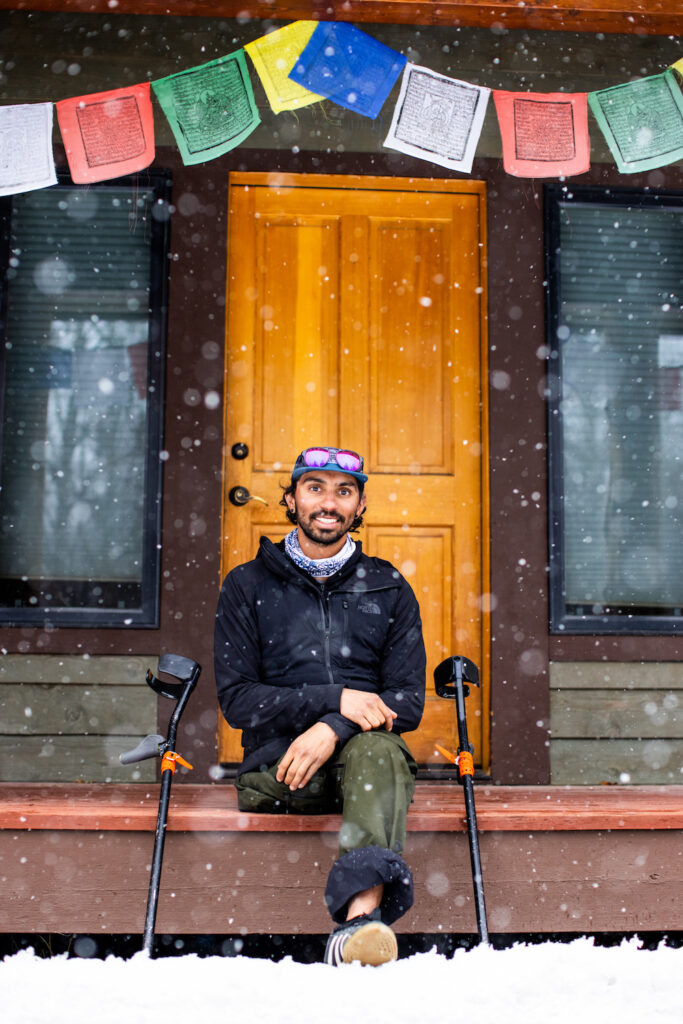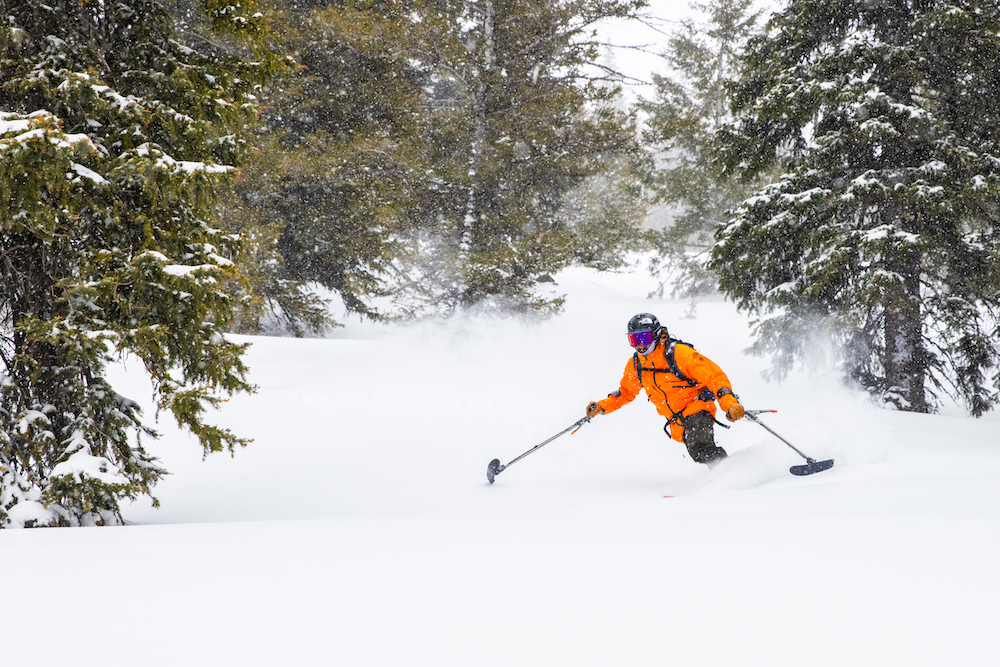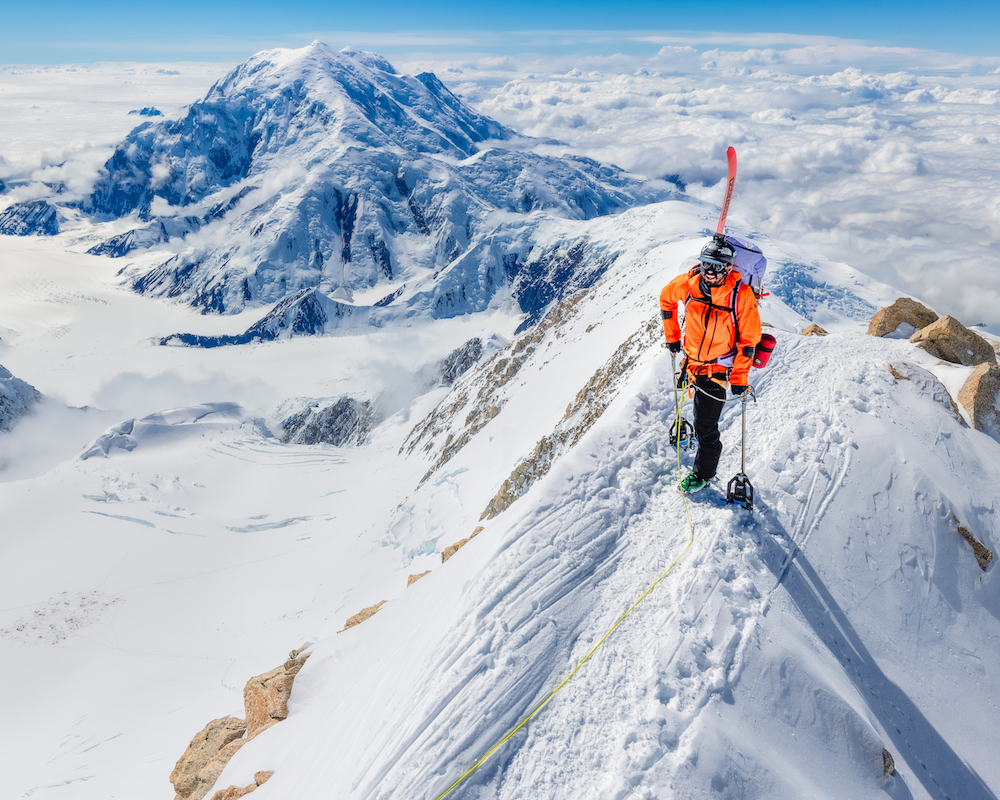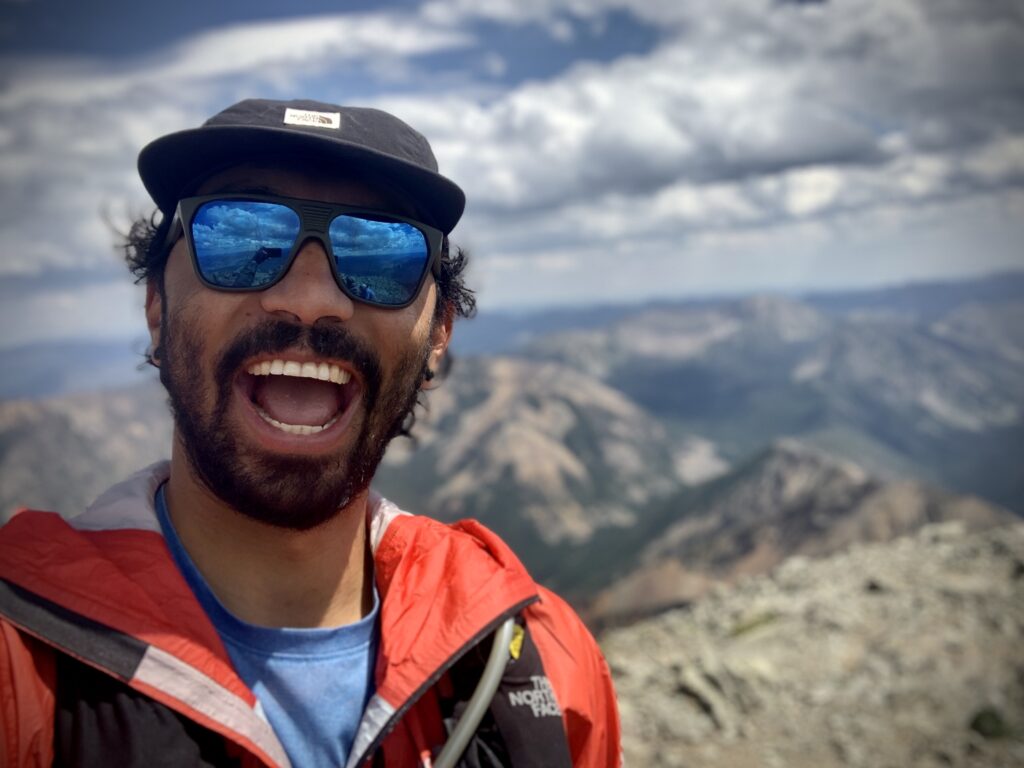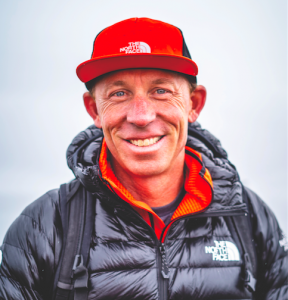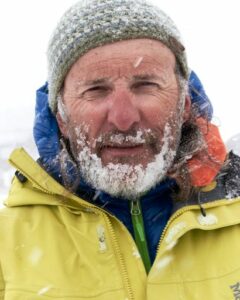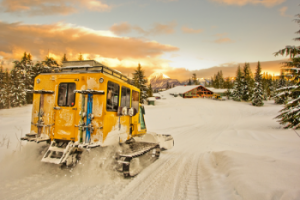He’s summited some colossal peaks, including climbing and skiing the highest mountain in the US. All on one leg, without a prosthetic. Amy Marwick meets Vasu Sojitra.
Amy Marwick: Hi Vasu! Great to speak with you. You’re at home in the Rocky Mountains just now, but tell us about your latest ski adventures?
Vasu Sojitra: Skiing Denali in Alaska [the highest peak in North America] was pretty monumental. We had a production team with us for the newest Warren Miller film. Two of us in the team of six have disabilities, both different types of leg amputations. We’re hoping to showcase how different each disability can be, how we don’t need the same kind of support or equipment, and how we each have different lived experiences [when Vasu was nine months old, he was diagnosed with septicemia, resulting in the amputation of one of his legs].
Prior to that, I was filming and skiing off the Skillet Glacier on Mount Moran, in the Grand Tetons, with The North Face. This one is more around me and my story. Breaking down disability and this concept of ‘inspiration porn’, the idea of objectifying disabled people for the benefit of non-disabled folks… That, “Good for you buddy…” condescending stuff.
I’m trying to make films with purpose. Trying to break down how disability isn’t just this one vision that a lot of people might have – there’s a lot more to my life than that. I try to make sure that my narrative is shared in addition to the narrative of the communities I’m a part of. Whether that’s communities of colour, the South Asian communities I’m a part of as an Indian American, or the disabled communities, physical or cognitive, you name it.
AM: Let’s jump back a bit to the beginning of your ski career, how did you first get into skiing?
VS: I grew up in Connecticut and started skiing when I was 10 years old. I was following my brother around a lot when I was younger. He and a friend wanted to go snowboarding at a local ski hill, and I wanted to do that too, but I was like… how? So, I just decided I’d ski instead. Serendipitously, another guy with one leg was skiing that day and he saw me and came up to me and was just like, “Keep going man!” and then just skied off! That really opened my eyes up to what adaptive sports were.
AM: How did you get to the level you are skiing at now?
VS: I mostly learned by following my friends around Vermont (where I later went to college), skiing at Mad River Glen, Sugarbush and Jay Peak. I never actually hung out with too many other amputees. We just kept going and got better with mileage. No one was giving me pointers, I was teaching myself how to ski steeper. Baby steps have led me to where I’m at now.
AM: Were there a lot of opportunities for you back then, or just a lot of barriers?
VS: My parents were always super supportive, always driving us to the ski hill. But it’s so expensive. Finance and transportation are definitely a big one.
A lot of people don’t have access to adaptive equipment, it’s so much more expensive than typical sports gear. From mono-skis, to the outriggers that I use, to handcycles that folks with lower body impairments use. All these things are exponentially more expensive than a bike or skis, or ski poles. It’s a huge barrier when it comes to getting access to opportunities outdoors, but for day to day life too.
We need to make good relationships with more marginalised communities, to make sure their narrative is being shared how they want it to be shared.
AM: Is there a good first step that the ski and outdoor industry can take to become more inclusive?
VS: It’s not easy and there’s not really one specific area. I don’t see it happening in this generation because we are trying to combat something that has been a part of our systems and structures for hundreds of thousands of years. People have to break down a lot of biases that percolate into our inner circles, to our leaders and our society.
We need to make good relationships with more marginalised communities, to make sure their narrative is being shared how they want it to be shared. That they’re being treated, the way they want to be treated.
We can all play our part when it comes to our language, actions, where we spend our money, what information we put out there and what communities we are interacting with. All these little things are part of that puzzle.
AM: Can you tell me a bit about the work you’re doing in skiing now?
VS: I’m part of a few different initiatives and I’m a Disability Access Strategist. Working with companies, breaking down what disability is, the language used, and helping them take action to provide access for disabled communities.
The Outdoor FUTURE Initiative is an outdoor equity fund to provide funding for underserved youth across the country to get outdoors. I’m also a co-founder of the Inclusive Outdoors Project. We provide mountain sports clinics for folks from the disabled communities, LGBTQ and communities of colour. Clinics around ice climbing, rock climbing, backcountry skiing and mountaineering. Those are in the works right now, so hopefully Covid doesn’t slow that down too much, but you just have to roll with the punches.
AM: What was the situation at your local mountain through last winter?
VS: I ski at Bridger Bowl and Big Sky resort, in Montana, and in the surrounding backcountry. At Bridger you had to reserve a day to go skiing, which kept the mountain at a nice capacity actually. But we were still allowed to go into the backcountry. Although no carpooling meant a lot more cars, which is of course horrible for the climate but that seemed like the only deterrent.
AM: What’s your favourite skiing around there?
VS: At Bridger I like to hike up onto the ridge. There’s a lot of unmarked terrain so you have to know where you’re going as you could easily get cliffed out. There’s a bit more of this slackcountry vibe. Big Sky is just massive so I’m still learning the terrain there. I really love skiing off of Lone Peak and some of the steeper stuff off of Challenger, and the A-Z Chutes and Dictator Chutes. There are a lot of different options, big mountain feel, with steep, exposed skiing.
AM: You’ve accomplished some serious firsts, including the first 720 spin by an adaptive skier, the first independent adaptive ascent of several summits, the first independent adaptive ascent and descent on skis of several others, now Denali and Mount Moran too. Is that something you’ve been aiming for or has that just happened naturally?
VS: It’s really come about naturally. Most things I touch happen to be firsts because a lot of disabled folks haven’t gotten this kind of access. I say ‘firsts’ as a kind of hook for people to understand that when disabled folks are provided resources we can do these things. We have a lot of power as disabled people, as long as we are supported in the ways that we want to be. That goes for anyone really. Support and grit combined can bring you to these metaphorical summits, these metaphorical firsts.
AM: Have you found yourself reaching a limit and drawing your line in the snow when it comes to risk?
VS: I’m still trying to find that. I hope I don’t find that in an aggressive way, like getting stuck in avalanche. I try to be really conservative when it comes to backcountry travel and choose my lines very particularly. With my ski ability I can pretty much ski anything up to 55 degrees, so it’s outside factors that I still have control over to watch – decision making or knowing whether or not to go into the mountains that day. I try to be as conservative as possible.
AM: When you’re approaching a big mountain mission, like Denali, what’s your preparation process?
VS: A lot of it is physical training. I’m always training for nothing and something at the same time. I try to stay at this plateau of strength, endurance and ability – it helps for these more ambitious goals like Denali and Moran.
AM: What’s are your key pieces of gear for big backcountry days?
VS: I enjoy skiing on my Faction skis, the Agent 3.0. They’re not floppy whatsoever. I’ve skied on soft backcountry skis before and I just don’t like them anymore. These skis have this stiffness, but they’re lightweight, a great balance between two extremes. When touring, definitely Dynafit bindings and I have my beacon, shovel, probe, Garmin inReach, a med kit and a repair kit on me at all times.
Obviously my outriggers, I can’t get into the backcountry without them. They are pretty much forearm crutches with little skis. I have snowshoe basket attachments that go on the bottom. I place both the outriggers in front of me and then skin and tech binding on my foot, and just kind of walk uphill slow and steady.
I created the attachments for the outriggers myself. It’s a plastic piece that was once the extender of a snowshoe. I’ve been using it for about 10 years and a lot of other adaptive athletes have hit me up to see how that works and then used it themselves which is awesome. We’re basically creating a new sport that people might not have thought of before: adaptive backcountry skiing.
AM: What’s on the horizon? Do you have any goals for the future?
VS: I think I will fade out of being an athlete, I don’t know when but I know I’ll probably destroy my body within the next decade, so who knows! My idea is to keep celebrating and elevating the communities I’m a part of through the work I’m doing. Making sure I’m supporting them in the ways that they want to be supported. That’s my number one goal.

